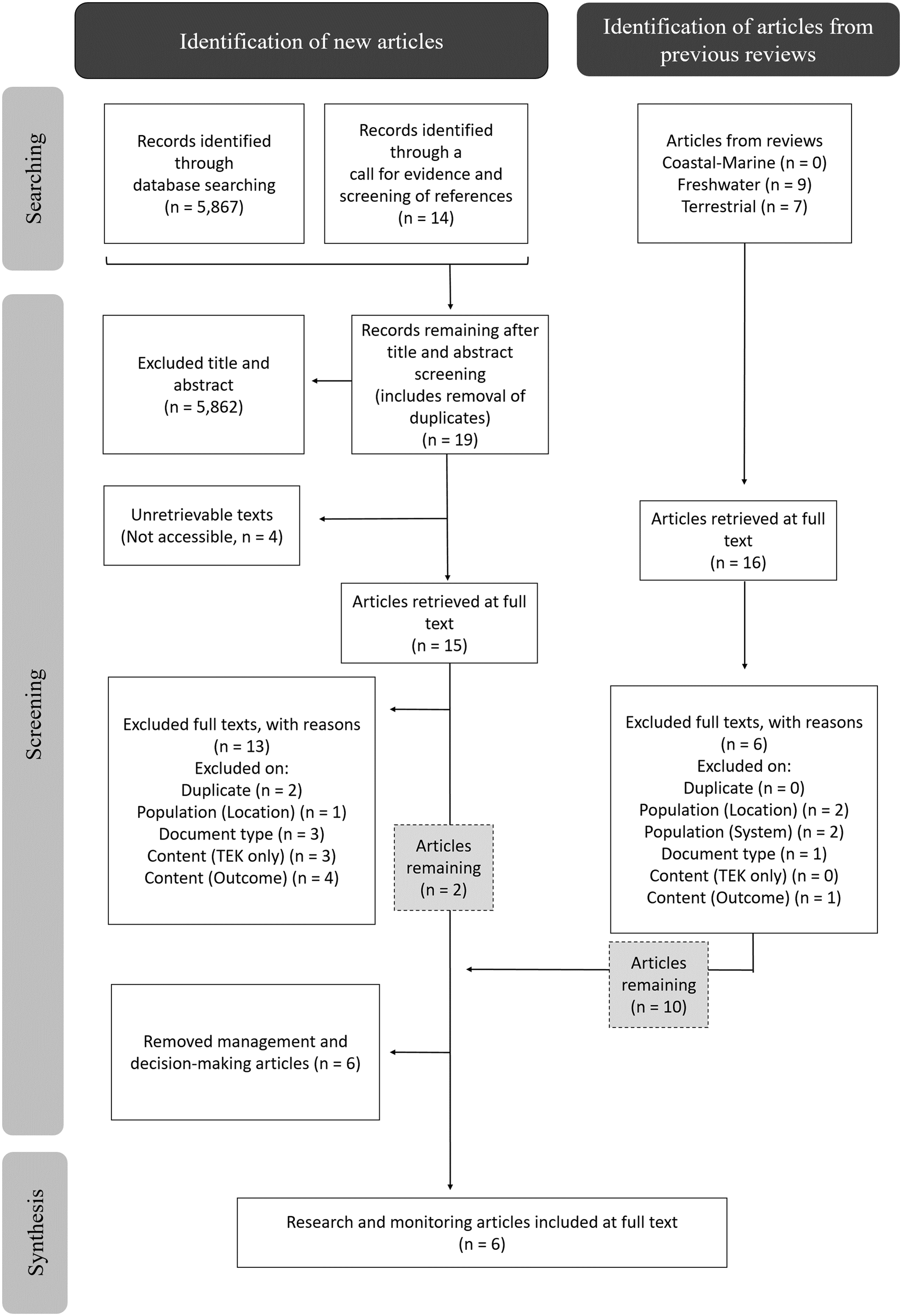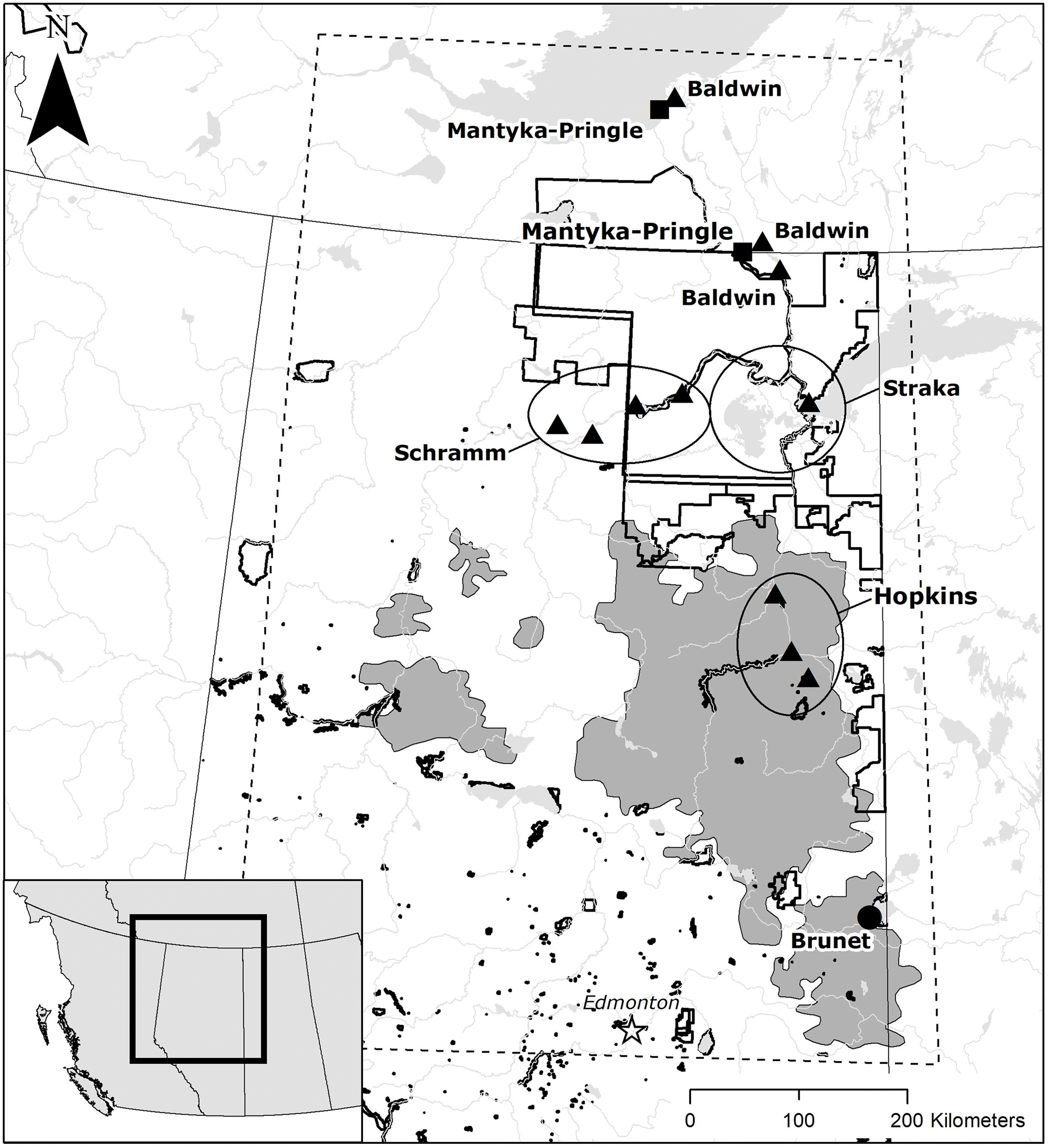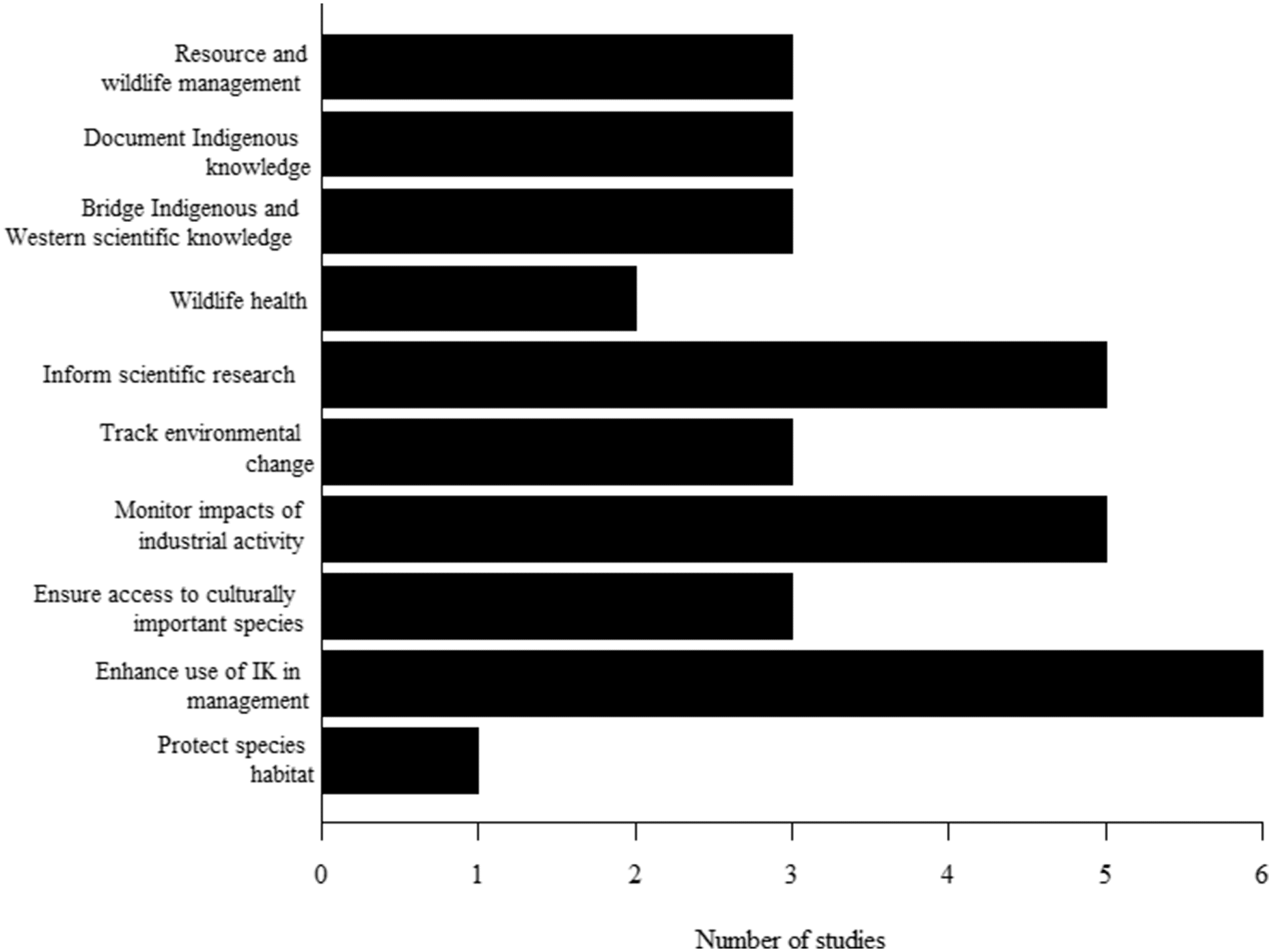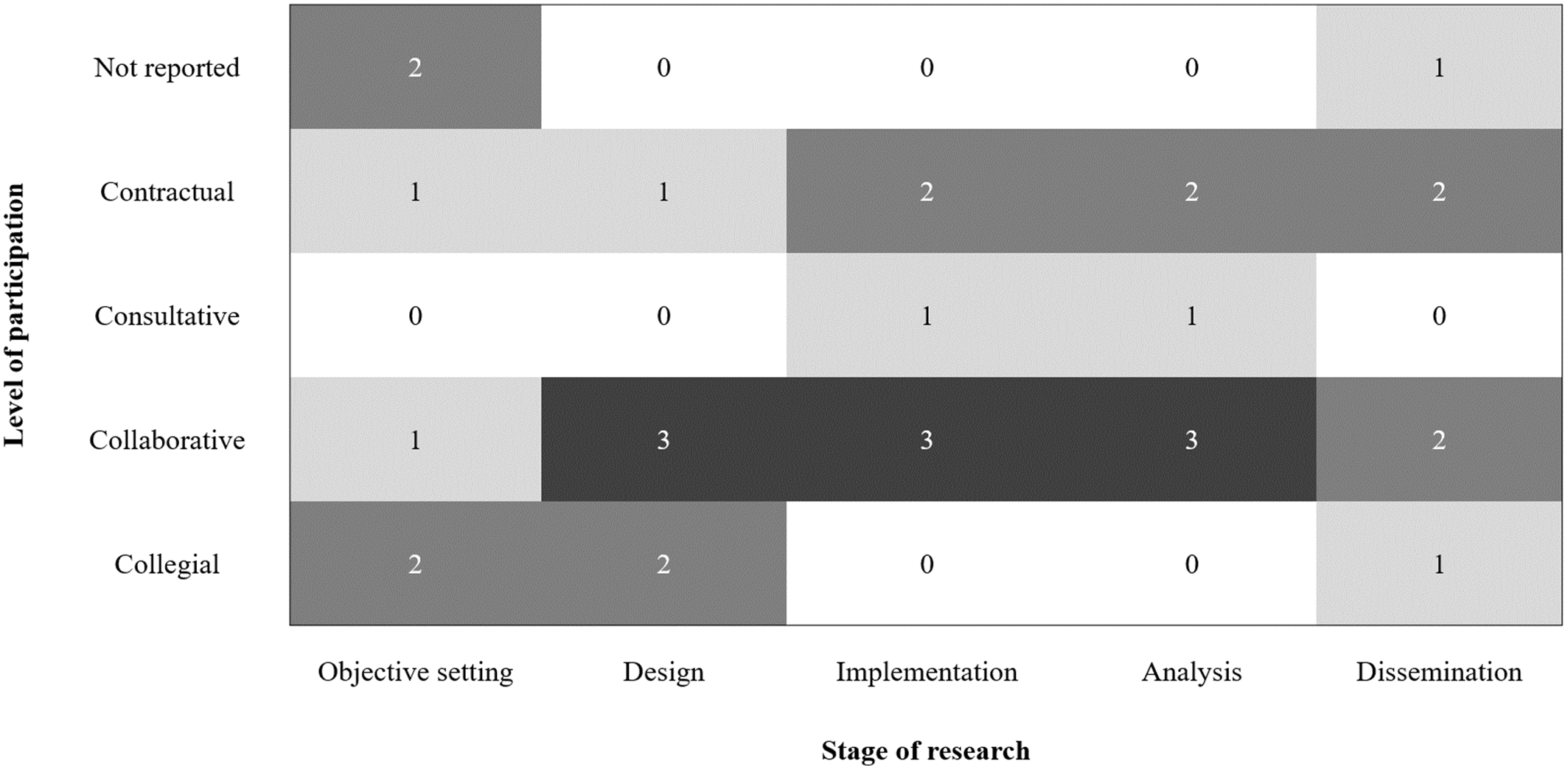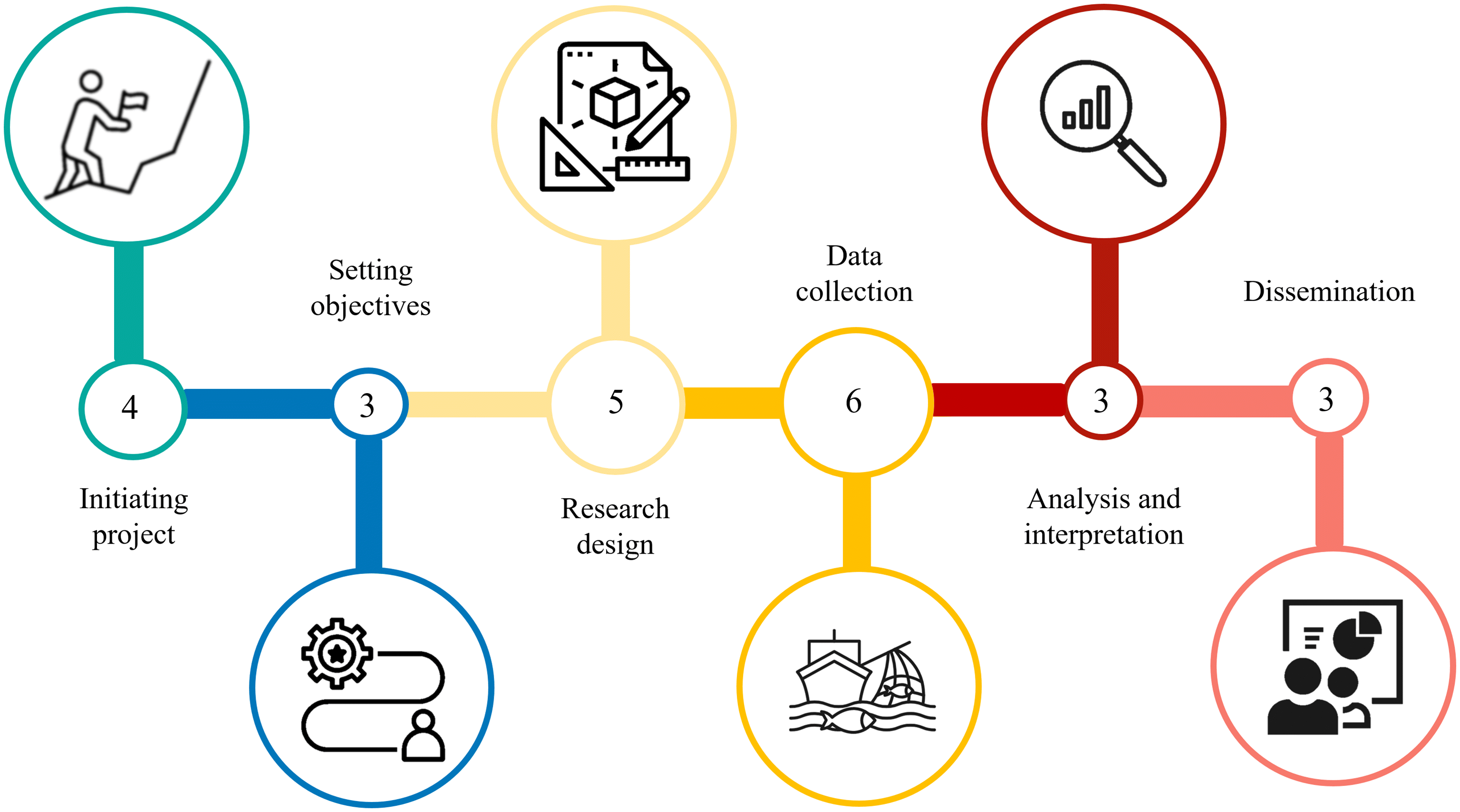Introduction
Braiding of knowledge systems refers to the process in which multiple types of knowledge are brought together (
Alexander et al. 2019a;
Johnson et al. 2016;
Rathwell et al. 2015;
Reid et al. 2021). Knowledge braiding can improve our understanding of socio-ecological systems and help build support and capacity to tackle long-standing and multifaceted environmental challenges (
Johnson et al. 2016). There has recently been substantial interest in Canada on how Indigenous ways of knowing can be braided or woven together with Western-based scientific approaches to help improve trust in ecological research and decision-making (
Government of Canada 2021;
Henri et al. 2020,
2021;
Johnson et al. 2016;
McGregor 2004a;
Popp et al. 2019). Western-trained non-Indigenous researchers and decision-makers are encouraged to prioritize Indigenous knowledge systems and recognize Indigenous history, governance structures, values, cultures, and the role of Indigenous peoples as stewards of the environment (
Ban et al. 2018;
Wong et al. 2020). By applying knowledge braiding that situates Indigenous ways of knowing and Western-based sciences as equally important and valid, ecological inquiry can be reshaped to foster ethical approaches that tackle environmental concerns to achieve goals for biodiversity conservation and sustainable use of the environment.
Knowledge, perceptions, and values underscore how individuals identify and conceptualize reality (
Cornell et al. 2013;
Masalo 2002;
Miller and Muñoz-Erikson 2018). Knowledge systems describe how we understand and organize information about the world around us, as well as how we transmit and use this knowledge in different ways (
Cornell et al. 2013;
Miller and Muñoz-Erikson 2018). Indigenous knowledge systems speak of the interconnectedness between all relations (i.e., humans, non-humans, and spirit) and emphasize land-based ethics and values (
Berkes 2012;
McGregor 2004b;
McGregor 2018b;
Supplementary Material Table S1). Indigenous sciences are embedded in Indigenous knowledge systems and apply an analytical lens to problem solving, such as observation (across long time scales – i.e., human generations) and interpretation, while also emphasizing that all teachings convey spiritual connections (
Kimmerer 2013;
Michell 2015). A number of academic (
Tengö et al. 2014) and regionally specific Indigenous approaches exist to guide the process of mobilizing multiple knowledge systems in ecological research (e.g., Two-Eyed Seeing, Two Row Wampum, Waka-Taurua;
Reid et al. 2021). In line with previous scholarly outputs co-authored by Indigenous community members in the Alberta oil sands region (
Hopkins et al. 2019), we have chosen the term “braiding” to describe the process of connecting Indigenous knowledge systems and Western-based sciences in a manner that maintains the integrity of each knowledge system and allows for mutual learning (
Alexander et al. 2019a;
Henri et al. 2021;
Rathwell et al. 2015). In this way, the braiding of knowledge systems challenges the simplified dichotomous discourse that leads to an evidentiary hierarchy and moves past the mechanistic and reductionist tendencies of Western-based sciences to create an opportunity to learn from alternative viewpoints and consider diverse ways of knowing (
Castleden et al. 2017).
Within ecological research, Indigenous perspectives and knowledge have strengthened Western-based sciences and the understanding of the mechanisms, interactions, and functions within ecological systems (
Ban et al. 2018;
Kimmerer 1998;
Kutz and Tomaselli 2019;
Pierotti and Wildcat 2000). Indigenous peoples have long recognized not only the importance of protecting the land and its inhabitants but also the role of the environment in cultural identity, knowledge transmission, cultural continuity, food sovereignty, and ceremony (
Fa et al. 2020;
Liboiron 2021;
Menzies et al. 2022). Acknowledging the roles that Indigenous stewardship, governance, and management systems have played in environmental protection and empowering Indigenous leadership in research not only helps to address power imbalances in the decision-making process (
Nadasdy 1999;
Nadasdy 2017;
Wheeler et al. 2020) but can also lead to more impactful research that better supports Indigenous communities and governments (
Ban et al. 2018;
Snook et al. 2018). Further, through the co-production of relevant research priorities and projects (
Norström et al. 2020), knowledge braiding can provide new ways forward to care for and protect the environment (
Ban et al. 2018), as well as spur progress in addressing environmental challenges (
Henri et al. 2021).
Western-based sciences long relied on the knowledge and exploitation of Indigenous peoples (
Liboiron 2021). As such, Western-trained non-Indigenous researchers have an ethical responsibility to prioritize and meaningfully engage with Indigenous peoples to advance reconciliation and renew relationships (
Wong et al. 2020). Distrust of Western-trained non-Indigenous researchers stems from multiple sources, including mistreatment of Indigenous peoples as research subjects (
Fitzpatrick et al. 2016), lack of consent (
Laycock et al. 2011;
Smith 2021), control of Indigenous data by external entities (
Battiste and Youngblood Henderson 2000a;
Mosby 2013), theft of cultural knowledge and resources (
Battiste and Youngblood Henderson 2000c), lack of transparency (
Goodman et al. 2018), and lack of access to results relevant to Indigenous communities (
Inuit Tapiriit Kanatami 2018;
Kovach 2009). On the other hand, calls for more ethically engaged research (
Trisos et al. 2021;
Riddell et al. 2017) have spurred discussions on culturally safe practices (
Ball and Janyst 2008), promoted Indigenous self-determination (
Battiste and Youngblood Henderson 2000a,
2000b;
Rasmus et al. 2020), and increased Indigenous representation and leadership in research (
Alexander et al. 2019a;
Government of Canada 2020a). Guidelines developed by Indigenous groups that address cultural research integrity, ethical data collection, intellectual property rights, and relationship building have provided further direction for Western-trained non-Indigenous researchers (e.g.,
Assembly of First Nations n.d.;
Akwesasne Research Advisory Committee and Akwesasne Task Force on the Environment 1996;
Inuit Tapiriit Kanatami 2018;
McGregor 2018c;
Mi’kmaw Ethics Watch 1999;
Nuu-Chah-Nulth Tribal Council 2008). Through the cultivation of respectful dialogue and collaboration, the braiding knowledge of systems can support ethical approaches to research that promotes equity, Indigenous self-determination, and begins to address the historical and ongoing injustices in Western-based academic research (
Inuit Tapiriit Kanatami 2018;
McGregor 2018b;
Reid et al. 2021;
Wilson et al. 2018).
The importance of braiding practices and Indigenous knowledge systems has been reflected in international and national policies developed by colonial institutions. At the international level, there is recognition of the value of Indigenous knowledge systems in biodiversity conservation policies and sustainable use principles and through the United Nations Declaration on the Rights of Indigenous Peoples (
Secretariat of the Convention on Biological Diversity 2020;
UN General Assembly 2007). However, despite calls for the incorporation of Indigenous knowledge systems in decision-making, Indigenous knowledge remains underrepresented globally and in national legislation (
McGregor 2016;
Secretariat of the Convention on Biological Diversity 2020;
Shea and Thornton 2019). In Canada, there is a mandate within many federal government departments to consider and respectively include Indigenous knowledge systems in environmental decision-making (e.g.,
Beaulieu-Guay 2022; Canadian Environmental Protection Act 1999 c. 33; Impact Assessment Act 2019 c. 28, s. 1; Migratory Birds Convention Act 1994 c. 22; Oceans Act 1996 c.31; Species at Risk Act 2002 c. 29), and several national funding agencies are calling on Western-trained non-Indigenous researchers to braid Indigenous knowledge systems and Western science equitably through the full cycle of research and monitoring (e.g., Natural Sciences and Engineering Research Council, Social Sciences and Humanities Research Council).
In this context, it is therefore essential to identify and understand the current practices and context of braiding of multiple knowledge systems for research and monitoring in Canada. We reviewed the publicly available peer-reviewed and grey literature addressing the braiding of Indigenous knowledge systems and Western-based sciences in environmental research associated with extractive industries in the Alberta oil sands region. Bibliographic information, as well as information related to research themes, study setting and design, knowledge systems, power relationships, colonization, research ethics, and the benefits and challenges of knowledge braiding were coded from the literature and used to assess trends in knowledge braiding in ecological research and monitoring in the oil sands region. Our aim was to provide an overview of the available published evidence on the braiding of Indigenous knowledge systems and Western-based sciences. In doing so, we sought to identify key gaps in the publicly available peer-reviewed and grey literature and provide recommendations to inform future ecological research and monitoring.
Limitations
Our results are based on the available published literature, but limitations in search strategies may exist and may have unintentionally affected our systematic review. Though we conducted an extensive search of the literature using multiple databases and tested for the sensitivity of our search strings and terms to yield the desired search results, changes in keywords or parameters could have yielded different search results. Publication bias could have also affected our search strategies. For example, the identity of the first author (e.g., nationality and gender) can affect publication and citation rate (
Einav and Yariv 2006;
Kothiaho 1999a,
Kothiaho et al. 1999b;
Møller and Jennions 2001;
Tregenza and Wedell 1997;
Tregenza 2002). Although we are unaware of any research that explicitly studies the role of Indigeneity on publication and citation rate, it is well known that Indigenous contributions have long been excluded from peer-reviewed authorship lists (
Cooke et al. 2021) and, given the extent of gender- and nationality-oriented citation bias, it is expected that similar patterns may be observed for Indigenous-authored papers. Further, some unpublished literature, particularly grey literature, may not have been accessible and, thus, was not included in our review (
Møller and Jennions 2001). Notably, Indigenous community-led reports are often held by Indigenous organizations and not widely shared (
Alexander et al. 2021b). Therefore, future work must directly engage with Indigenous community members, with the aim to co-develop research and, where permitted, braid knowledge held by communities with Western-based sciences. However, it is important to note that there are many reasons for Indigenous knowledge to be held by communities and not in the public record, including, but not limited to, cultural appropriateness, concerns over fragmentation of knowledge, and lack of need or desire to participate in colonial systems. Lastly, search strategies would have been unable to identify literature where Indigenous knowledge holders were not acknowledged or where the Indigenous knowledge component was published as a separate study (
Alexander et al. 2021b).
We also used a narrow definition of knowledge braiding (i.e., focused on articles that reported empirical results from both Indigenous knowledge systems and Western-based natural sciences) and recognize that there is a continuum of braiding strategies available. Articles from
Baker (2020) and
Natcher et al. (2020a,
2020b), for example, demonstrated highly collaborative research that involved interviews and surveys of Indigenous communities in the oil sands region (i.e., TEK only); however, by the definitions determined in our protocols they were missing braiding with Western-based scientific data related to ecosystems, habitat, and biodiversity and were excluded from analysis. Similarly, articles that did not detail the ways in which researchers engaged with or involved Indigenous communities could not be recognized or coded for braiding. For example, there are a number of reports on environmental co-monitoring programs (e.g.,
Beausoleil et al. 2021) and research (e.g.,
Kelly et al. 2010;
Thomas et al. 2017) in the Alberta oil sands region that discuss the importance of biodiversity and potential contamination in relation to Indigenous communities, but because knowledge braiding is not part of the published record they were not captured using a systematic literature search as we have undertaken here. Finally, we acknowledge that many methodologies and methods used in the social sciences also constitute a form of Western-based knowledge and evaluation of the braiding approaches used in this field should be investigated.
Results
Literature search and bibliographic information
A total of 5,881 articles were identified through four bibliographic databases, calls for evidence, and screening of bibliographies. Screening at the title and abstract stage excluded 5,862 articles (
Fig. 1). Four articles were unretrievable (
Supplementary Material Table S2), even via institutional subscriptions or interlibrary loans, and were, therefore, not screened for relevance to the review (
Fig. 1). This left 15 articles to review at full-text, with an additional 16 articles retrieved from the datasets from the previous systematic maps (
Fig. 1). Full-text screening of the 31 articles available resulted in a further 19 articles being excluded, with removals occurring because of duplication (n = 2), location (n = 3; i.e., study not located in the Alberta oil sands and greater impact region), system (n = 2; i.e., study not related to biodiversity or climate change), document type (n = 4; i.e., study not including qualitative or quantitative data), traditional ecological knowledge (TEK) only (n = 3; i.e., study did not include Western sciences), or outcome (n = 5; i.e., study did not include Indigenous or Western science component or braiding;
Fig. 1). A total of six “management and decision-making” articles were excluded to focus discussion on the remaining six “research and monitoring” articles deemed relevant to the braiding of knowledge in the oil sands region (
Fig. 1;
Supplementary Material Table S3). However, in comparison to the total “management and decision-making” and “research and monitoring” articles (n = 12), a search of four databases yielded 224 articles related to ecological studies in the Alberta oil sands that used just Western sciences. Moreover, there were 0.025 articles/1,000 km
2 published in the oil sands region that braided Indigenous knowledge systems and Western sciences compared to 0.020 articles/1,000 km
2 across Canada.
Research and monitoring articles that braided knowledge were published between 2002 and 2020, which included a report (n = 1) published in 2002 and peer-reviewed literature (n = 5) published between 2017 and 2020. Peer-reviewed literature was published in journals with a focus on environmental sciences (n = 3) or resource development and management (n = 2), and the majority (n = 4) of the articles were published in journals with a focus on research that crosses disciplines. For all articles included in the review, first authors were principally affiliated with academic institutions (n = 4) or government (n = 2; provincial: Government of Alberta; federal: Parks Canada). Articles that included Indigenous authorship (n = 3) were represented by individuals (n = 2), committees (n = 1), or communities (n = 1). However, no first authors were identified as Indigenous within the context of the papers.
Research themes
Informing scientific research and monitoring regarding the impacts of industry in the oil sands region were the main focus of the articles in our review. Authors published using a variety of keywords (
Supplementary Material Fig. S1), but many included terms for environment and wildlife (n = 4; e.g., “environment,” “ecological,” “wildlife,” species names), monitoring and management (n = 4; e.g., “monitoring,” “(co-)management,” “assessment,” “indicator/indicator species”), Indigenous knowledge (n = 3; “Indigenous knowledge,” “traditional knowledge”), and (or) regional-specific information (n = 2; e.g., “Alberta,” “Lower Athabasca Region”). Articles in our review centered on fundamental (n = 5) and applied (n = 1) research but focused principally on monitoring industrial activity (n = 5) and informing scientific research (n = 5;
Fig. 3). In these articles, researchers were addressing resource and wildlife management (n = 3), documenting Indigenous knowledge (n = 3), bridging Indigenous and Western-based scientific knowledge (n = 3), tracking environmental change (n = 3) and wildlife health (n = 2), documenting access to culturally important species (n = 2), and protection of species habitat (n = 1;
Fig. 3). All studies (n = 6) in our review looked at enhancing the use of Indigenous knowledge in environmental management (
Fig. 3). Specific wildlife species were the main research subject across articles (n = 4) and centered on aquatic (n = 2; i.e., mussels and fish) and terrestrial species (n = 2; i.e., moose, woodland caribou), while community interactions and ecosystem interactions were the focus of a single article each (
Table 2).
Articles mentioned different industries and activities within the oil sands region, including resource extraction (n = 6), agriculture (n = 4), mining (n = 2), forestry and logging (n = 2), hydroelectric development (n = 2), pulp and paper mills (n = 2), and water withdrawals (for the oil sands, agriculture, or municipalities; n = 1). Two articles focused specifically on environmental contamination and investigated metals (n = 2) and polycyclic aromatic hydrocarbons (n = 2) in aquatic wildlife. Monitoring industries and activities in the oil sands region led to investigations of various environmental impacts and concerns, such as environmental health concerns (n = 6), species loss (n = 6), contamination (n = 5), quality and quantity of water (n = 2), cumulative effects (n = 2), climate change (n = 2), habitat loss and (or) fragmentation (n = 2), and wildlife disease (n = 2), in addition to socio-cultural impacts and concerns related to hunting and harvesting (n = 5), human health (n = 4), food safety and (or) quality (n = 3), economic or financial concerns (n = 3), spiritual (n = 3), social (e.g., cultural practices, n = 2), tourism and travel (n = 2), and emotional/psychological distress (n = 1).
Study setting and design
The composite map of the oil sands region, including both the geological area of the oil sands deposits and the surrounding impact area, is shown with the study locations and the research themes (
Fig. 2). There were 12 study locations identified in the articles in our review, with 10 situated north of the Athabasca and Peace River Oil Sands deposits. Two locations were in Canadian national parks and protected areas, with an additional four situated adjacent to Wood Buffalo National Park.
Articles employed a broad range of methodological approaches and methods to collect and braid Indigenous and Western scientific knowledge (
Table S1). Community-based participatory research was the main methodology employed in research (n = 3), followed by cultural consensus analysis (n = 1), Two-Eyed Seeing (n = 1), participatory modeling (n = 1), and experimental approaches (n = 1). All methodologies were Western-based, with the exception of the one article which applied a Two-Eyed Seeing approach. Two articles did not report on the methodology used for the research. All six articles distinguished between Indigenous and Western-based methodological approaches or methods.
Methods used to collect and interpret Indigenous knowledge included interviews (n = 4), surveys (n = 2), workshops (n = 2), GIS (n = 1), Bayesian network modeling (n = 1), participant observation (n = 1), participatory mapping (n = 1), and ground truthing (n = 1; i.e., land-based interviews,
Supplementary Material Table S1;
Hopkins et al. 2019). While abiotic sampling (n = 3), counts (n = 2, including census data and stock assessments), field observations (n = 2), and secondary data (n = 2) were the main methods used to obtain Western scientific data, articles also employed document review (n = 1), chemical analysis (n = 1), GIS (n = 1), dissections and tissue sampling (n = 1), and computer simulations (n = 1). Data that derived from secondary sources included counts, abiotic samples, and biological samples, and in one instance these data were collected with involvement from Indigenous communities.
Indigenous involvement in research was critical to the articles that we reviewed. Two studies involved First Nations communities (n = 2), while the remaining studies (n = 4) sought involvement from both First Nations and Métis communities. Knowledge holders were often described by the authors of the articles in our review as Elders (n = 6), but researchers also obtained Indigenous knowledge from community members <29 years old (n = 2), 30–59 years old (n = 3), and 60+ years old (n = 3). The age of the participants was not reported in three studies. Indigenous knowledge was provided by knowledge keepers (n = 6) or active harvesters (n = 4), and gender was reported in four of the articles, all of which had both male and female participation. Community involvement occurred at almost all stages in the research process (
Fig. 4;
David-Chavez and Gavin 2018) but was generally collaborative (i.e., community members and researchers worked together) at the design, implementation, and analysis stages of the research. All studies derived from multi-year research collaborations (n = 6), with studies being initiated through mutual agreement between the community and researchers (n = 3) or community-initiated (n = 1). A single study was initiated by academic researchers, and one study did not report who initiated the research.
Indigenous community members were credited for their knowledge contributions and efforts either through co-authorship (n = 3) or in the acknowledgments (n = 6). Credit was given for project initiation (n = 4), objective setting (n = 3), research design (n =5), data collection (n = 6), analysis and interpretation (n = 3), and dissemination (n = 3;
Fig. 5). However, only one article that acknowledged Indigenous community involvement in dissemination provided details on whether results were accessible to the community and indicated that research dissemination occurred through in-person meetings or presentations, written communications (i.e., reports, living documents), and social media.
Knowledge systems
Definitions of Indigenous knowledge from
Houde (2007) were used to classify how authors described the knowledge systems. Indigenous knowledge was described in some studies as factual observations, classifications, or system dynamics (first face; n = 4) but also as resource management systems adapted to local environments (second face, n = 1) and as factual knowledge regarding past and current uses of the environment (third face, n = 2). Two studies identified Indigenous knowledge as grounded in specific ethics and values (fourth face, n = 0), while none indicated Indigenous knowledge as a vector for cultural identity (fifth face, n = 0). Two studies also mentioned an underlying culturally based cosmology (sixth face; n = 2). Western sciences were defined in three articles, all of which emphasized how Indigenous knowledge compared to the reductionist and analytical approaches of Western-based sciences. Lastly, researchers sought Indigenous knowledge to provide both contemporary (n = 3) and historical context (n = 3) or to aid in the collection and analysis of data (n = 3).
Power relationships, colonization, and ethical considerations in research
Articles discussed aspects of colonization (n = 4) more frequently than power relationships (n = 2) in research. Moreover, though findings were generally considered relevant to the community (n = 5), the majority of articles did not provide details on the ethical considerations or procedures guiding the research (
Table 3). Half of the studies acknowledged following some form of ethical guidelines (n = 3), underwent institutional review for research ethics (n = 1), or followed community protocols (n = 3), while the other half of the articles discussed participant (n = 3) or community consent (n = 1;
Table 3). Where consent was indicated, free consent (n = 2; i.e., respondents participated voluntarily) was given or researchers provided information prior to consent being given (n = 1). Data sovereignty was mentioned in a single article, while no authors acknowledged intellectual property rights or acknowledged that participants were offered anonymity (
Table 3).
Benefits and challenges of knowledge braiding
Authors often discussed a variety of challenges to the braiding of Indigenous knowledge systems and Western-based sciences (n = 5). Power asymmetries (n = 2) and bias (n = 2) were considered to be the main hurdles to overcome to effectively braid different perspectives on the environment, while inadequate/inconsistent funding (n = 1), local capacity (n = 1), epistemological differences (n = 1), pace of research (n = 1), training requirements (n = 1), and the situation-specific nature of Indigenous knowledge (n = 1) were also mentioned. Many benefits and outcomes were also seen to come from collaborative research and knowledge braiding. Half of the articles reported proposed (n = 4) and realized (n = 3) outcomes from the studies, and benefits and outcomes of the studies included: the potential to inform management (n = 6); increased interest in Indigenous knowledge by scientists (n = 5); contributions to scientific research and knowledge (n = 4); increased environmental awareness (n = 3); ensuring not only Western-based sciences are used in decision-making (n = 2); local communities feeling that their perspectives are being considered (n = 1); and an increased opportunities for inter-generational knowledge transmission (n = 1).
